Easy Ciabatta Bread
As an amazon associate I earn from qualifying purchases.
This easy ciabatta bread recipe will be your new go-to. Just 4 ingredients & it bakes up so light, airy, & chewy, with a thin, crisp crust!
Today I’m bringing you another fabulous bread recipe to add to your files! Ciabatta!
I see how much you love my crusty French baguette recipe, soft whole wheat bread, and easy homemade croissants, and I’m happy to give you more to enjoy.
Like those other beloved bread recipes, my focus here was to simplify the recipe as much as possible. There are plenty of other ciabatta bread recipes out there, but I truly think this one is the best because it’s so easy.
It all happens in just one bowl, with only 4 simple ingredients. The active time is minimal; it’s mostly just letting the dough rest and do its own thing. And I’ve even included instructions for an overnight option, which breaks things up over 2 days and probably even improves the bread’s flavor!
The final result is so airy and light, with tons of air pockets running throughout and a thin, crisp crust. The bread is soft and moist inside, with a chewy edge that’s so satisfying! I think you’re really going to love it.
WHAT IS CIABATTA BREAD?
Ciabatta is pronounced like this: cha-BAh-tuh. It’s an Italian word that means “slipper.” It’s named this way because the shape of the loaf is like a slipper: sort of a rounded-off, flat-ish rectangle.
It’s made with a very wet dough, and it’s pretty much a no-knead recipe. This results in an extremely airy interior, and a crisp, brown, chewy crust. As you can see from the photos here, there are tons of air bubbles running all throughout this bread, and they’re all different sizes. This is exactly what you want!
I love this bread just dipped in a little olive oil and maybe a drizzle of balsamic vinegar. It’s simple and pure and rustic as can be.
But it’s also great sliced, buttered, and sprinkled with garlic, then toasted in the oven. So yummy with your pasta dinner!
Or it can be split horizontally and used to make panini. It’s the perfect shape and texture for that.
However you decide to portion it out, it makes a perfect starter or side to a hearty one-pot meal. Think mushroom risotto, corn chowder, or chili. Or even a salad! Like this classic Cobb salad.
HOW TO MAKE CIABATTA
To make things a little easier, let’s divide this method down into 5 simple steps:
- Making the Dough
- Allowing it to Rest
- Shaping the Loaf
- Letting it Rise
- Baking the Bread
MAKING THE DOUGH
In a large mixing bowl, whisk flour and salt together. All-purpose flour is fine for this ciabatta recipe. No specialty flours needed here!
Then, proof your yeast in a little bit of warm water. The water should be warm, not hot. Aim for the temperature of a baby’s bath, around 105 to 110 degrees F.
Once the yeast mixture is starting to look foamy, stir it into the flour and salt. It will be extremely dry at this point.

Then, add in cool water, just a little bit at a time, stirring after each addition.
It will seem very wet and loose, and you might think you put in too much water. Don’t worry! This is right! It’s just how ciabatta bread dough is meant to be.

Cover the bowl with plastic wrap and allow the dough to rest for 30 minutes.
ALLOWING IT TO REST
After that initial 30 minutes, this dough will have a total of 2 more hours of resting time. During this time, it will be folded twice.
I like to use a plastic dough scraper for this. If you don’t have one, here’s a link: Plastic Dough Scraper. Or you can just use your fingertips, but you’ll probably want to flour them first since the dough is so sticky.
- Top to bottom
- Bottom to Top
- Left to Right
- Right to Left
Just grab it from the edge and fold it over itself. That’s all the kneading it will get and this will happen twice: once after the initial 30-minute rest, and then again after an hour.
You can get a better idea of how this folding process works by viewing the video in the recipe card below.
After the second fold, rest it one more hour, and then it’s time to shape the loaf.
SHAPING THE LOAF
There’s not a whole lot to shaping this loaf, since the dough is so loose it kinda just falls into a flat-ish lump.
I have instructions for making ciabatta rolls below, but if you want a larger loaf, just scrape the dough onto a parchment-lined baking sheet, flour your hands, and gently pat/encourage it into a rectangular form.
LETTING IT RISE
Then, loosely cover it with oiled plastic wrap and allow it to rise in a warm place for 30 to 45 minutes.
Make sure your plastic wrap is very well-oiled. If it’s not, it will stick to the dough and when you go to pull it off it will tear the unbaked bread and you will lose volume.
At this point, you want to handle it so, so gently so the air doesn’t get knocked out of it!
I just spray my wrap generously with non-stick spray.
BAKING THE BREAD
While the loaf is rising, preheat the oven to 475 degrees F. <-- Not a mistake! This bread bakes in a very hot oven and that's how you get that shatteringly crisp crust. When you preheat the oven, place a large, empty dish on the bottom rack. I just use a square cake pan, but anything that's oven-proof will work. Once the oven is fully up to temperature and the ciabatta has risen to roughly 1.5x its original size, gently & carefully peel the oiled plastic wrap off and spray the unbaked bread with water. Here's a link to the spray bottle I use: Rayson Spray Bottle. This is also to help form the crusty-crust.
Place the bread on the center rack in the oven and immediately pour about 2 cups of water into the empty dish on the bottom shelf. Working quickly so as not to allow any heat or steam to escape, shut the oven door and let the ciabatta bake until it’s very brown and crusty on the outside. It should make a hollow sound when tapped. The internal temperature should register about 190 degrees F.
In my oven, this takes around 35 to 45 minutes, but every oven is different so you’ll want to use your judgment.
OVERNIGHT OPTION
If you split the steps up over a 2-day period, it makes things a little easier, as well as improving the flavor of the bread. This is because of fermentation! A slow-ferment brings out all the yeasty, tangy flavors.
You can learn more about slow fermentation here: New York Bagel Recipe.
Follow all the recipe instructions up to “Letting it Rise.” At this point, cover it with oiled plastic wrap and place it in the fridge. It can hang out there for up to 2 days. Or you can freeze it for up to 2 weeks (more on that below).
When you’re ready to bake it, take it out and uncover it while the oven preheats. Then just bake it off according to the instructions.
CIABATTA ROLLS
If you prefer your ciabatta in roll form (great for sandwiches!), just divide it into 6 equal portions at the shaping stage.
Sprinkle the parchment-lined baking sheet generously with flour, scrape the dough onto it, and use a bench knife to cut it into little squares or rectangles.
Then space them apart and follow the recipe instructions from there.
The bake time will probably need to be reduced due to the smaller size, but you’ll want to look for the same hallmarks: brown and crusty, hollow-sounding, and around 190 degrees internal temperature.
FREEZING THE DOUGH
If you’d like to freeze the unbaked loaf or rolls, place them in the freezer on the sheet pan until frozen solid.
At that point, they can be wrapped in plastic wrap and slipped into freezer bags.
They’ll keep in the freezer for up to 2 weeks and can be popped out as needed, placed on a tray while the oven preheats, and baked off for fresh-baked bread whenever the craving strikes.
HOW TO STORE
Once baked, this bread will keep for a couple of days, tightly wrapped at room temperature. If you want to extend the shelf life to a week or two, place it in the fridge.
I often freeze baked bread as well, either whole or pre-sliced. If you pre-slice it, it thaws very quickly at room temperature or in a 170 degree F oven. Just pop it into a zip-top bag and it will last for a few months in the freezer.
A FEW MORE OF MY FAVORITE BREAD RECIPES:
As an amazon associate I earn from qualifying purchases.
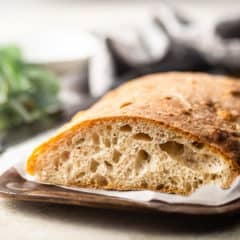
Easy Ciabatta Bread
Ingredients
- 2 cups (250 g) all-purpose flour
- 1 teaspoon (6 g) kosher salt
- 1/4 cup (59.15 g) warm water, (around 105 degrees F)
- 1 teaspoon (12 g) active dry yeast, (approx. half a packet)*
- 3/4 cup (177.44 g) cool water
Instructions
- Place the flour and salt in a large mixing bowl, and whisk to combine.
- Sprinkle the yeast over the warm water and stir to combine.
- When the yeast mixture looks foamy (after about 5 minutes) stir it into the flour mixture (it will be very dry).
- Add the cool water, a little at a time, stirring after each addition. (Once all the water has gone in, the dough will be very wet and sticky.)
- Cover with plastic wrap and allow the dough to rest at room temperature for 30 minutes.
- Fold the dough over on itself: top to bottom, bottom to top, left to right, then right to left.
- Cover and rest for 1 hour, then repeat the folding process one more time.
- Cover and rest for 1 more hour.
- Scrape the dough onto a parchment-lined baking sheet, and pat it into a rectangular shape (for a loaf), or divide it into 6 equal portions and shape each into a small square or rectangle (for rolls).
- Cover lightly with oiled plastic wrap and allow to rise at room temperature for 30 to 45 minutes, or in the refrigerator overnight.
- Preheat the oven to 475 degrees F and place an empty oven-safe dish on the bottom rack.
- Mist the unbaked bread with water and place it in the center rack of the oven.
- Pour about 2 cups of water into the empty dish and bake until the bread is brown & crusty, makes a hollow sound when tapped, and registers an internal temperature of 190 degrees F (approx. 35 to 45 minutes).

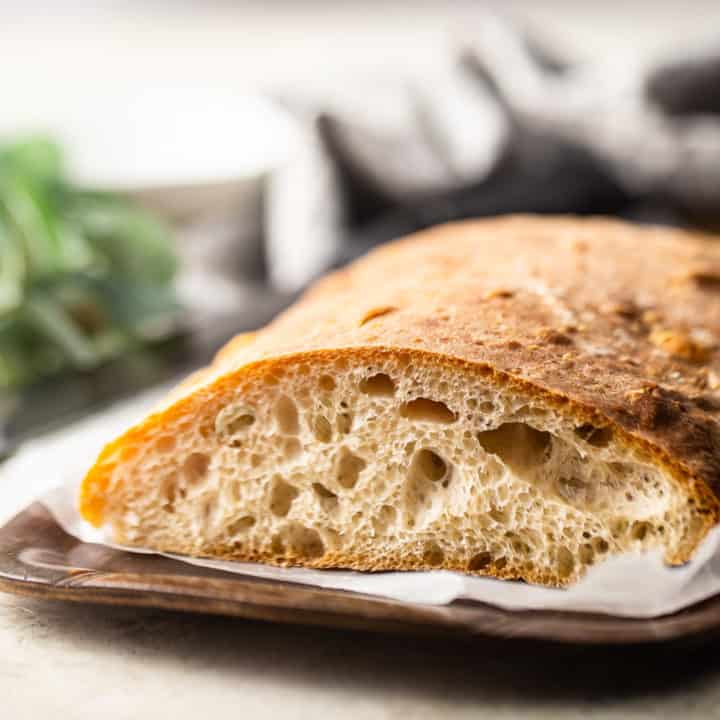
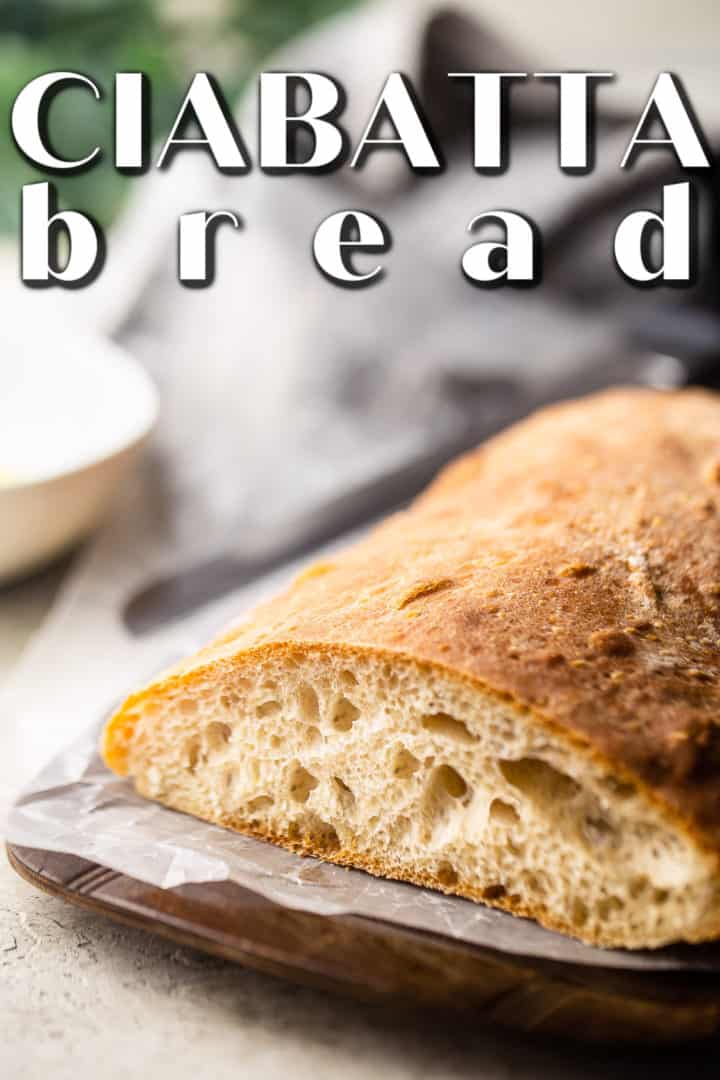
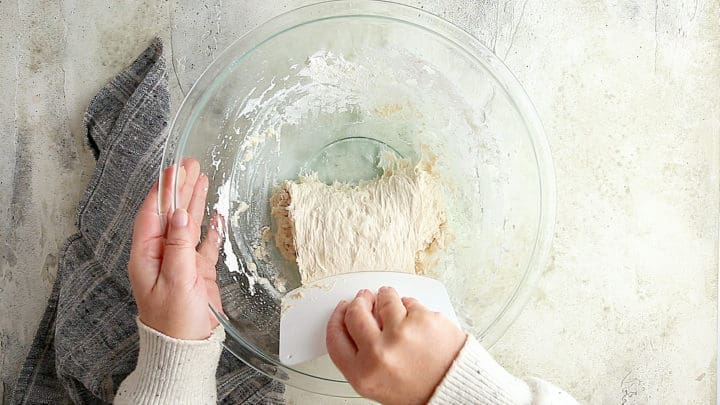
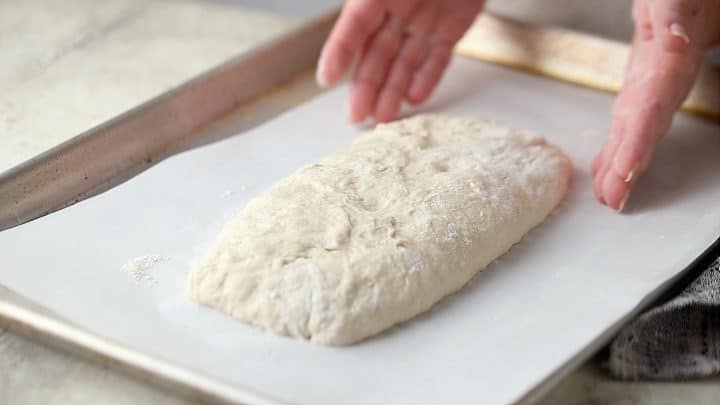

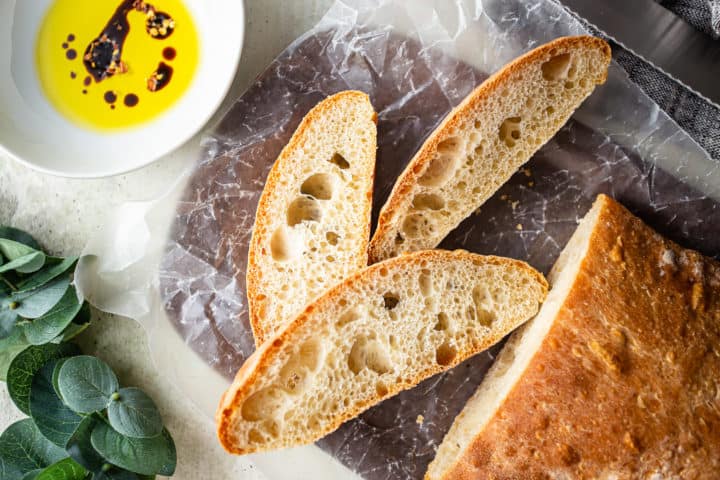











The bread came out BEAUTIFUL!! This recipe was easy to follow and understand. I can see myself making this bread again and again. It is delicious.
So happy you like it! TYSM for the positive feedback!
Where did you find the reusable cover for the mixing bowl. Searched everywhere and no luck!
Hey there! It’s just plastic wrap. I like the Press ‘n Seal brand.
I was so excited about this bread. I baked mine for 30 minutes ( 15 minutes under the suggested bake time) and it came out burnt to a crisp.
That is very odd and I’m so sorry that happened to you. I’ve made this recipe a handful of times and have never experienced that problem. Looking through the other comments here, it doesn’t seem that anyone else has either. I’m wondering if your oven could be off? Maybe try putting one of those thermometers in that can hang off a rack. It’s not uncommon for ovens to wander out of calibration over time. And definitely keep an eye on things as they’re baking! It’s not a good idea to just walk away, or you could end up with an unhappy surprise!
No oil?
There is no oil in ciabatta. If you’re looking for a bread recipe that contains oil, try typing “focaccia” into the search window at the top of this site.
Any idea on how long it takes to bake? Cant wait to try this recipe!
Hey Koko! Yeah in my oven it usually takes around 40 minutes. Good luck!
I made this recipe into Ciabatta Rolls and my family loved them!
I am wondering if you have tried making this recipe as Gluten Free?
That’s so great to hear! I have not, but if you do I’d love to hear about the results!
I did make Ciabatta Rolls a Gluten Free flour and they also came out wonderful!
Great to know! TYSM!
I tried this recipe using instant yeast with excellent results! Thank you! Can you use a loaf pan instead of just letting the dough flop onto the baking sheet? It’s so much easier to slice a shapely loaf.
That’s great! I would think so- I can’t imagine why not? But I haven’t tried so I can’t say for sure. If you do, I’d love to hear about the results!
I made this and it was delish. Can I make it using whole wheat flour? or 1/2 all purpose and 1/2 whole wheat?
Hey Donna! I haven’t tried so I can’t say for sure, but I would think so! My experience with whole wheat flour tells me you may need a little less of it, since it tends to yield a dryer dough. Good luck!
And don’t use a glass pan for steam and pour cold water in it. It just may be a glass bomb in the oven…lol —1st time ciabatta maker
Ugh, I hear you!!! Been there, done that.
Just to clarify, I assume the ciabatta needs to be folded a total of 4 times within a two-hour time span. Also, can I sub bread flour for the all-purpose flour?
Yes, you can if you like. The dough gets 4 folds (top to bottom, bottom to top, left to right, right to left), twice. Hope that makes sense!